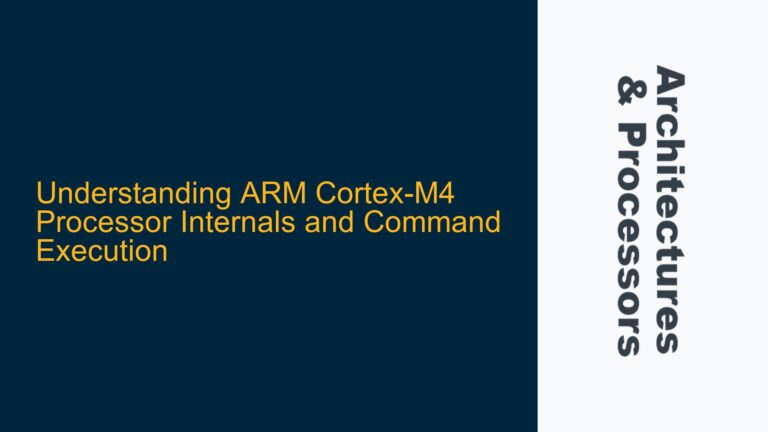ARM Cortex-M Vector Table Alignment and Memory Allocation Challenges
Relocating the vector table to RAM in ARM Cortex-M microcontrollers, such as the Microchip SAMD21 and SAMD51, presents a unique set of challenges, particularly when it comes to alignment requirements and memory efficiency. The vector table, which contains the addresses of exception handlers and interrupt service routines (ISRs), must be aligned to specific boundaries depending on the processor architecture. For instance, the SAMD21 requires a 256-byte alignment, while the SAMD51 demands a 1024-byte alignment. However, the actual size of the vector table is often significantly smaller than these alignment requirements—180 bytes for the SAMD21 and 612 bytes for the SAMD51. This discrepancy leads to substantial memory wastage when using standard memory allocation techniques.
The primary issue arises from the alignment constraints imposed by the ARM architecture. The Cortex-M series processors require the vector table to be aligned to a boundary that is a power of two, and this alignment must be at least as large as the number of exceptions and interrupts supported by the processor. This alignment ensures that the processor can quickly locate the correct exception handler by using the exception number as an index into the vector table. However, this requirement often results in a significant amount of unused memory, as the allocated block must be large enough to satisfy the alignment, even if the actual vector table is much smaller.
In addition to the alignment issue, there is the challenge of dynamically allocating memory for the vector table at runtime. Standard memory allocation functions like aligned_alloc require that the size of the allocated block be a multiple of the alignment, which exacerbates the memory wastage problem. For example, if the alignment requirement is 1024 bytes and the vector table size is 612 bytes, aligned_alloc would allocate a full 1024-byte block, resulting in 412 bytes of wasted memory. This inefficiency is particularly problematic in resource-constrained embedded systems where every byte of RAM is precious.
Another consideration is the need to maintain flexibility in the system design. The goal is to create a library that allows for the optional relocation of the vector table to RAM, such that if the feature is not used, the associated memory is not allocated or is eliminated during the linking process. This requires careful management of the memory allocation and linker script configuration to ensure that the vector table can be dynamically relocated without interfering with other system components or wasting memory unnecessarily.
Memory Allocation Strategies and Alignment Constraints
The alignment requirements for the ARM Cortex-M vector table are dictated by the processor’s architecture and are non-negotiable. However, the way in which memory is allocated to meet these requirements can be optimized to minimize waste. One approach is to use a global structure in the .bss section with the __attribute__((aligned(x))) attribute, where x is the required alignment. This method ensures that the vector table is properly aligned without requiring dynamic memory allocation. However, this approach has limitations, particularly when the alignment value is not known at compile time or when the vector table size varies between different processor models.
The use of aligned_alloc is another option, but as previously mentioned, it requires that the size of the allocated block be a multiple of the alignment, which can lead to significant memory wastage. This is particularly problematic in systems with strict memory constraints, such as the SAMD21 and SAMD51 microcontrollers. To mitigate this issue, one could consider using a custom memory allocator that is aware of the alignment requirements and can allocate memory more efficiently. However, this adds complexity to the system and may not be feasible in all cases.
Another potential solution is to use the linker script to place the vector table at a specific location in memory. This approach allows for precise control over the memory layout and can ensure that the vector table is properly aligned without wasting memory. However, modifying the linker script can be complex and may interfere with other system components or features, such as garbage collection during the linking process. Additionally, this approach may not be flexible enough to support dynamic relocation of the vector table at runtime.
A more flexible approach is to use a combination of linker script modifications and runtime memory allocation. By defining a custom section in the linker script for the vector table, it is possible to allocate memory for the vector table at runtime while still ensuring proper alignment. This approach allows for greater flexibility in system design and can help to minimize memory wastage. However, it requires careful management of the linker script and memory allocation routines to ensure that the vector table is properly aligned and that the memory is used efficiently.
Implementing Efficient Vector Table Relocation with Minimal Memory Overhead
To implement an efficient vector table relocation strategy with minimal memory overhead, it is necessary to carefully balance the alignment requirements, memory allocation techniques, and system flexibility. One effective approach is to use a combination of linker script modifications and runtime memory allocation, as described above. This allows for precise control over the memory layout while still providing the flexibility to dynamically relocate the vector table at runtime.
The first step in this process is to define a custom section in the linker script for the vector table. This section should be aligned to the required boundary and should be placed in a region of memory that is not used by other system components. For example, the following linker script snippet defines a custom section for the vector table with a 1024-byte alignment:
SECTIONS {
.vector_table 0x20000000 : {
. = ALIGN(1024);
*(.vector_table)
}
}
This ensures that the vector table is properly aligned and placed at a specific location in memory. The next step is to allocate memory for the vector table at runtime and place it in the custom section. This can be done using a combination of aligned_alloc and linker script modifications. For example, the following code snippet allocates memory for the vector table and places it in the custom section:
void *vector_table = aligned_alloc(1024, 612);
if (vector_table == NULL) {
// Handle allocation failure
}
// Copy the vector table to the allocated memory
memcpy(vector_table, &__vector_table_start, 612);
// Set the vector table address in the SCB
SCB->VTOR = (uint32_t)vector_table;
In this example, aligned_alloc is used to allocate a block of memory that is aligned to a 1024-byte boundary. The size of the allocated block is 612 bytes, which is the size of the vector table. The memcpy function is then used to copy the vector table from its original location to the allocated memory. Finally, the SCB->VTOR register is set to the address of the allocated memory, which relocates the vector table to the new location.
This approach ensures that the vector table is properly aligned and placed in a specific region of memory, while still allowing for dynamic relocation at runtime. However, it is important to note that this approach may still result in some memory wastage due to the alignment requirements. To further optimize memory usage, it may be necessary to use a custom memory allocator that is aware of the alignment requirements and can allocate memory more efficiently.
Another consideration is the need to maintain flexibility in the system design. The goal is to create a library that allows for the optional relocation of the vector table to RAM, such that if the feature is not used, the associated memory is not allocated or is eliminated during the linking process. This can be achieved by using conditional compilation and linker script modifications. For example, the following code snippet demonstrates how to conditionally allocate memory for the vector table based on a compile-time flag:
#ifdef USE_DYNAMIC_VECTOR_TABLE
void *vector_table = aligned_alloc(1024, 612);
if (vector_table == NULL) {
// Handle allocation failure
}
// Copy the vector table to the allocated memory
memcpy(vector_table, &__vector_table_start, 612);
// Set the vector table address in the SCB
SCB->VTOR = (uint32_t)vector_table;
#endif
In this example, the USE_DYNAMIC_VECTOR_TABLE flag is used to conditionally compile the code that allocates memory for the vector table. If the flag is not defined, the code is not compiled, and the memory is not allocated. This allows for greater flexibility in system design and ensures that the memory is only allocated when necessary.
In conclusion, relocating the vector table to RAM in ARM Cortex-M microcontrollers presents a unique set of challenges, particularly when it comes to alignment requirements and memory efficiency. By carefully balancing the alignment requirements, memory allocation techniques, and system flexibility, it is possible to implement an efficient vector table relocation strategy with minimal memory overhead. This approach involves using a combination of linker script modifications, runtime memory allocation, and conditional compilation to ensure that the vector table is properly aligned and placed in a specific region of memory, while still allowing for dynamic relocation at runtime.






